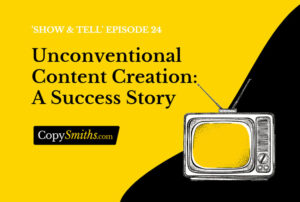Home » Content Marketing » The Dos and Don’ts of Content Strategy Development

The Dos and Don’ts of Content Strategy Development
You just made a business website, but it looks empty without articles.
Your competitors are trending on Twitter, and you’re still sharing 2012 memes.
That’s not good. You need solid content to engage with audiences, boost brand visibility, and drive sales.
How do you do that? Like with many other things in business, it’s about planning, re-planning, executing, and then planning some more.

We at CopySmiths are experts at content production, ensuring that everything you publish works for your business.
“It has been a pleasure working with the CopySmiths team – they are reliable, efficient, and great at curating high-quality content on complex subjects. They always provide regular updates on all article orders and deliver on their promises.” Sander Tamm, e-student.org
We also share educational resources to help every aspiring company and e-commerce business reach their desired audiences.

Let’s explore the vital dos and critical don’ts of your content strategy.
Content Strategy Development: What to Do
Do: Consider the Big Picture
Your content strategy isn’t a standalone feature of doing business online.
Incorporate it into your overall business plan, considering the same principles you would for any other aspect of managing your company.
Use this three-part statement that informs your plan and strategy, revolving around your current and future goals and values you wish to communicate.
| Goals and Values | |
| Mission | The purpose of your business |
| Vision | What you plan on achieving in the future |
| Values | Your core beliefs and principles |
Blogging is essential for commerce, and it should keep these factors in the limelight. Consider how you can communicate your significance, principles, and goals through everything you publish.
For instance, if you sell high-end fashion products, discuss the importance of style in your customers’ lives. That way, what you publish ties into your other marketing efforts.
Do: Put Audiences First
It’s tricky to produce content that your audiences will like. How can a group of 30-something authors write for teenagers? (Quite well, actually.)
It’s even trickier to launch a content strategy that doesn’t work. Forgetting about your buyer persona is a surefire way to miss the mark with your content.
On the other hand, writing for the buyer helps you produce content that speaks directly to your audiences, responds to their fears and desires, and leaves them feeling heard and understood.
Consider the following factors in mapping your target customers:
| Personal and demographic info | Age, gender, marital status, education, income |
| Professional info | Job title, industry, level, tools used |
| Values and fears | What is important to them? How can your product help? What do they fear? How can you respond to that fear? |
| Goals and challenges | What are their goals in their personal and professional lives? What challenges could they face in pursuing those goals? |
| Location | Where do they spend their real-life days? What about online spaces? Where do they get their information? What social networks do they frequent? |
Once you have these answers, incorporate them into your content marketing strategy.
Do: Plan Ahead
If something new and exciting happens in your industry, you’ll want to respond by sharing your opinions. However, some planning does help.
Organize your editorial calendar around stable topics such as guides and product comparisons. That way, you have plenty of time to ensure it’s well-written and posted according to schedule.
Search engines and readers love stability. A calendar makes it much easier not to allow your content strategy to fall by the wayside.
Do: Respond to Feedback
Audiences are bombarded with brands left, right, and centre. They like seeing companies that listen and respond.
Despite how it might seem, negative feedback does wonders for your business.
Always keep track of how many reads, views, and likes you have received and factor that into your future endeavours.. Drop the posts that don’t work and focus on what’s gaining responses.
Content Strategy Development: What Not to Do
Don’t: Ignore Published Content
As your reach grows, chances increase that readers will take a look at everything you’ve published before.
Revisit your old posts and update them to match your evolved vision and mission. Don’t be afraid to delete those that are downright problematic.
Also, update product and service information on all outlets.
Don’t: Put Keywords Over Quality
Long-tail keywords are essential to targeting niche demographics. Once you reach the audience, they will read your blogs and social media posts.
Poor writing that puts keyword stuffing over content quality is bad news.
You wouldn’t say:
‘Small gardening shovels are an excellent tool for your garden. A good small gardening shovel makes your job much easier.’
Instead, make your content about small gardening shovels, and keyword-rich content will flow.
Tip: Instead of stuffing keywords for SEO purposes, focus your content around such buzzwords and phrases. Use them as you’re designing your editorial calendar.
Don’t: Be Afraid to Change
You might’ve developed a content strategy that looked fantastic on paper, informed your staff, and launched it. It’s not long before you learn it’s not bringing in traffic.
Go back to the drawing board.
Never give in to the sunken cost fallacy. Half of a decent procedure yields better results than an entire approach that’s not working for your business.
Key Takeaways
We cannot overstate the power of content marketing for your business. It boosts organic traffic and helps you reach broad online audiences.
Remember the following cornerstones of a quality content strategy:
- Always plan.
- Put value over quantity.
- Keep your readers at the forefront.
- Let the plan evolve with new information.
These goals become attainable with the right writing team in your corner. Employ voices that write well, and business prosperity follows.
Schedule a consultation. We’ll make your content dreams become a published reality.
Frequently Asked Questions
What Is a Content Strategy?
Your content strategy is your plan to achieve business goals through content production and publishing. It revolves around the following questions:
- Who is your target audience? What demographic will be reading your content?
- What value does your content bring to your audiences?
- How will your content stand out from the competition?
- Which publishing formats will you use?
- Where will you publish?
- How often will you publish?
A reliable strategy answers these questions and outlines every next step of the process.
Where Should I Publish Content?
There are two primary channels for publishing your written and filmed content—your website/blog and social media platforms.
Pick the best platforms based on your audience demographics and tailor your content to suit the funnel. Leave long-form studies for your website and focus your social media profiles on bite-sized content chunks, such as tweets and Facebook statuses.
Is SEO Part of My Content Strategy?
Search engine optimization ultimately helps your audiences find you and, from you, the answers to their questions. A strategy that uses content to speak to customers and provide value naturally speaks to SEO, as well.
CopySmiths
I'm Katrina McKinnon, founder of CopySmiths and Small Revolution. In my 20 years of experience, I have helped online businesses create high-performing content specifically on an eCommerce store's blog. Find me on LinkedIn and Twitter.

CopySmiths offers the best blog writing services for online stores.
If you'd like us to write blog articles for you, click here.
Most Recent
- 3 Bold Questions You Should Ask When Hiring A Content Writer

- 5 Practical Reasons You Should Use a Blog Post Template

- 4 Amazing Benefits of Using a Title Generator for New eCommerce Blogs

- 10 Awesome Bio Examples Your Online Store Blog Should Emulate

- 8 Basic Steps to Successful Content Development Every Time

Podcasts
Got a question?
Ask our friendly team about our article writing services.
Subscribe to CopyZine
Monthly, hand-picked stories of the best in eCommerce Content.





